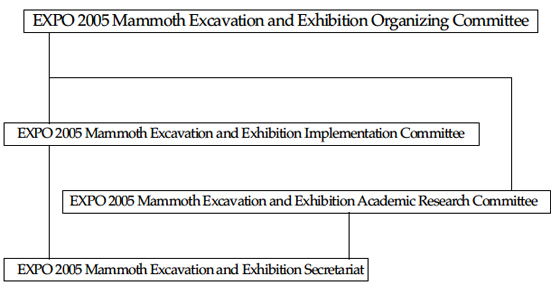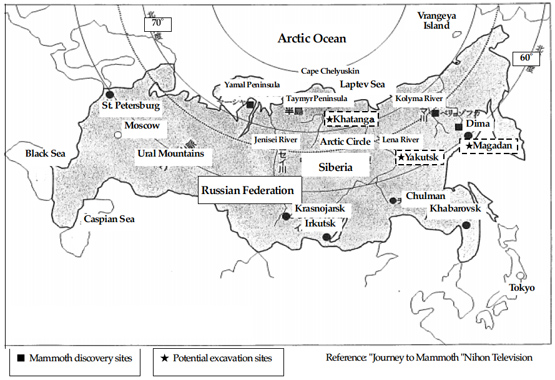Bringing a Perfectly Intact Mammoth to EXPO 2005 AICHI, JAPAN:
Mammoth Excavation and Exhibition Organizing Committee Launched, Survey Team to Head to Russia in August
July 17, 2003
The Japan Association for the 2005 World Exposition has been considering excavating the remains of a mammoth, an animal believed to have become extinct between 7,000 and 8,000 years ago, from the permafrost in Siberia and making it a featured exhibition at EXPO 2005.
Today these plans come to fruition with the launch of the Mammoth Excavation and Exhibition Organizing Committee, which will be the parent organization that will promote this effort. The organizational structure and future schedules have been decided upon, and a survey team will be put together and dispatched in early August for the purpose of selecting a location.
As it was a large mammal that coexisted with humans during the Ice Age, the mammoth can be said to be a precious inheritance of the Earth. While a large number of partial specimens have been excavated through the efforts of survey teams from around the world in the past, regrettably a perfectly intact specimen has yet to be discovered.
If a completely intact frozen mammoth can be successfully excavated and displayed exactly the way it existed thousands of years ago, this will of course greatly impress visitors to EXPO 2005. But more than that, it is believed that doing so will make a major contribution to the future study of extinct animals and the process of bringing them back.
The organizational structure, schedule, and plan to dispatch the survey teams are as follows:
1. Organizational structure: Refer to attachment 1
2. Schedule: Refer to attachment 2
3. Plan for survey teams
A) Time frame of dispatch (tentative):
First survey - For approximately one month beginning in early August 2003
Second survey - For approximately one month beginning in early September 2003
B) Area of survey: Khatanga and Yakutsk (refer to attachment 3)
Depending on the results obtained by the first survey, Magadan may be added to the list of candidate sites.
C) Members of the survey teams: Takeshi Matsuda, Shigeru Taguchi, and Hidemaro Korenaga, members of the Mammoth Excavation and Exhibition Implementation Committee.
* Depending on the results obtained by the first survey, additions and alterations may be made to the second survey team.
Overview of Organizational Structure for EXPO 2005 Mammoth Excavation and Exhibition Project

Members of EXPO 2005 Mammoth Excavation and Exhibition Project
1. EXPO 2005 Mammoth Excavation and Exhibition Organizing Committee
Honorary Chairman
Akito Arima, Chairman of the Japan Science Foundation
Chairman
Shinji Fukukawa, Chairman of the Japan Association for Creative Events
Members
Toshio Nakamura, Vice Secretary-General of the Japan Association for the 2005 World Exposition
Naoki Suzuki, Professor, the Tokyo Jikei University School of Medicine (Chairman of EXPO 2005 Mammoth Excavation and Exhibition Academic Research Committee)
Akio Etori, Professor, Edogawa University; Vice Director of the Science Museum, Tokyo (Chairman of EXPO 2005 Mammoth Excavation and Exhibition Implementation Committee)
Haruhiko Akemine, President of Force Corp.
Takeshi Matsuda, President of Nature Network Co., Ltd.
Hiromitsu Taira, General Manager of Nippon Express Co., Ltd. * Additional members will be brought in from cooperating corporations and organizations.
Advisers
Takashi Hamada, Chairman of the Japan Science Society
Jiro Ota, Chairman of Edogawa University
Shigenori Ikemoto, Chairman of Nippon Veterinary and Animal Science University
2. EXPO 2005 Mammoth Excavation and Exhibition Secretariat
Imperial Tower 13F, 1-1-1 Uchisaiwai-cho Chiyoda-ku, Tokyo 100-0011, Japan c/o Technova Inc.
Tel. 81-3-3508-4805
Secretary-General
Hori Takanobu, President of Technova Inc.
* Operations will be undertaken with the cooperation of the Japan Science Foundation.
3. EXPO 2005 Mammoth Excavation and Exhibition Academic Research Committee
Chairman
Naoki Suzuki, Professor of the Tokyo Jikei University School of Medicine
Members
* Members are under considerations.
Advisers
Haruhiko Akemine, President of Force Corp.
4. EXPO 2005 Mammoth Excavation and Exhibition Implementation Committee
Chairman
Akio Etori, Professor of Edogawa University; Vice Director of the Science Museum, Tokyo
Members
Takashi Honjo, Director-General of Management and Administration Office, Japan Association for the 2005 World Exposition
Takeshi Matsuda, President of Nature Network Co., Ltd.
Shigeru Taguchi, Producer of World Staff Co., Ltd.
Hidemaro Korenaga, Producer of World Staff Co., Ltd.
Kotaro Wada, Director of Nature Network Co., Ltd.
Kazuyuki Suzuki, Director of Nature Network Co., Ltd.
Seiji Nakao, Director of Nature Network Co., Ltd.
Eiji Mizushima, General Manager of the Japan Science Foundation
Hidetoshi Tashiro, Manager of the Japan Science Foundation
Yuui Suzuki, General Manager of Nippon Express Co., Ltd.
Advisers
Naoki Suzuki, Professor, the Tokyo Jikei University School of Medicine
Haruhiko Akemine, President of Force Corp.
* Experts in various fields will be used in accordance with the progress of the project.
EXPO 2005 Mammoth Excavation and Exhibition Project Schedule
First Stage (August-September 2003): Collecting information, conducting surveys, and negotiating for the purpose of selecting an excavation site
(1) First survey (for a period of one month beginning August 2003)
A) Moscow
- Asking government-related organizations for cooperation and collecting information
B) Area around Khatanga
- Collecting information from related organizations in the area
- Exchanging information with another survey team
- Surveying the area
C) Area around Yakutsk
- Collecting information from related organizations in the area
- Exchanging information with another survey team
- Surveying the area
(2) Second survey (for a period of one month beginning September 2003)
- Deciding on location of surveys based on information from the first survey (If the results of the first survey are not satisfactory, the Magadan area and other locations may be added as candidates.)
- Beginning a test excavation if the information from the first survey has a high degree of accuracy

Second Stage (May-September 2004): Excavation
Third Stage (October 2004-May 2005): Transportation of excavated specimen to EXPO 2005 venue; handling various procedures; construction of exhibition area
Fourth Stage (March-September 2005): Exhibition of specimen at EXPO 2005
Fifth Stage (October 2005 and beyond): Passing it on to the future


